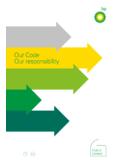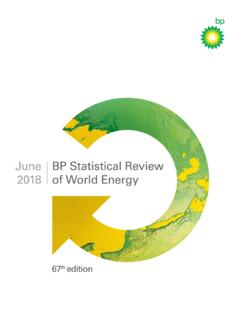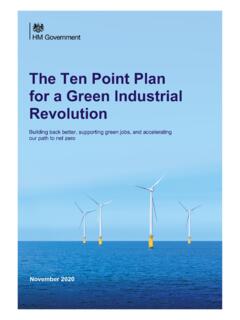Transcription of Advancing the energy transition - BP
1 Advancing the energy transitionThe changing energy mix 3 Our strategy for the energy transition 4 Our commitment to advance a 6low carbon future Reducing emissions in our operations 7 Improving our products 11 Creating low carbon businesses 15 Accrediting our lower carbon activities 20 Using carbon offsets to support our 22low carbon ambitionsAdvocating for better policy and 23clearer incentivesKeys to success 24 The world is growing like never before, creating opportunity for billions of people. And all this growth requires energy . But as the world demands more energy it also demands that it be produced and delivered in new ways, with fewer BP, we embrace this dual challenge.
2 We have always looked to the future, adapted to change and met challenges like this head on. In this report, we examine how the energy world is rapidly changing, set out our low carbon ambitions and show how we are helping to advance the energy transition . Our experienceTwo decades ago, BP was one of the first energy companies to address the threat of climate change, pioneering alternatives like wind, solar and biofuels. We invested billions of dollars to make renewable energy a genuine of our investments worked out others did not. We were early, but I don t think we were wrong, because we learned valuable lessons along the deliver significantly lower emissions, every type of energy needs to be cleaner and better. A race to renewables will not be enough. That s why we are making bold changes across our entire from Bob DudleyOur low carbon ambitionsHere s how we are doing it: by reducing, improving, creating.
3 We re reducing emissions in our own operations; we re improving our products to help customers lower their emissions; and we re creating low carbon businesses. We are able to do this because of the innovative mindset of our people, our unique global research network, and the potential being unleashed by digital, big data and advanced technologies. This is allowing us to rapidly develop new ways to tackle emissions and improve efficiency, and to deploy these throughout BP. ReduceWe have set clear targets for emissions in our operations. So even as our business grows to meet growing demand, our net carbon emissions will not. We ll deliver this through sustainable reductions in our greenhouse gas emissions, by keeping a cap on our methane intensity and, as necessary, with offsets to keep net emissions at 2015 levels. We appreciate that there s more to do but we see this as a critical next step in our journey to reduce emissions.
4 ImproveWe re producing more natural gas a lower carbon alternative to coal and a complement to renewables. And we re working with auto manufacturers to create fuels and lubricants that allow drivers to go further with fewer emissions. 1BP Advancing the energy transitionIntroduction from Bob Dudley continued Create We are also creating low carbon businesses, such as LightSource BP, adding solar to our long-established renewables businesses in wind and biofuels. And some of our most exciting work is in venturing, where we are making investments in a range of smart technologies and experimenting with new business models. The energy landscape is evolving quickly and no single solution is emerging as yet. But we will be ready to scale up the most promising innovations into viable new businesses as the future becomes clearer. To validate all these efforts and encourage further action, we are introducing an accreditation programme across BP that we re calling Advancing Low shared challengeI am surrounded by people who want to play their part: engineers, scientists, technicians, economists, specialists in energy policy.
5 We are all hungry to do more. But we know that on our own, it is never going to be transition to a lower carbon economy requires everyone to be involved, from individual consumers to global corporations, and from local authorities to national governments. When we all work together we can make progress, as happened in Paris in 2015. We support the ambitions of the historic Paris Agreement, but the pledges made then and the actions taken since will not be enough to prevent a 2oC rise. To help meet the challenge, we believe carbon must be priced and only governments can do a price on carbon and you incentivize everyone to use less energy . You incentivize the use of lower carbon fuels. And you incentivize innovation and the hunt for all kinds of ways to lower emissions. All my experience over the past 40 years in the energy business tells me that when you inspire people, human ingenuity will find won t be easy, true progress seldom is, but BP will never stop working to help the world keep moving and, more importantly, keep Advancing .
6 Bob DudleyGroup chief executive, BP2BP Advancing the energy transitionThe demand for energy continues to grow largely driven by rising incomes in emerging economies and a global population heading towards nine billion by 2040. At the same time, the energy mix is changing as technology advances, consumer preferences shift and policy measures evolve. Renewables are now the fastest- growing energy source in history and we estimate that they could account for 14% of all energy consumption in 2040 if not more. That said, oil and gas could meet at least 40% of the world s energy needs in 2040 even on a course that s consistent with the Paris goal of limiting global warming to less than 2 C. The changing energy mix Gas offers a much cleaner alternative to coal for power generation and can lower emissions at scale. It also provides a valuable back-up for renewables intermittency, delivers heating at the high temperatures required by industry and is increasingly used in transportation.
7 Oil is the primary fuel for transport today. We expect its share of the total energy mix will gradually decline as we see more energy efficiency in traditional engines, greater use of biofuels and natural gas, and growth in fully electric and hybrid vehicles in the years ahead. With oil and gas in high demand for years to come, it s essential that action is taken to reduce emissions from their production and use. energy consumption 2040 projectionsEvolving transition In this scenario, government policies, technology and social preferences evolve in a manner and speed seen in the recent past. The growing world economy requires more energy but consumption increases less quickly than in the transition This scenario sees carbon prices rising faster than in the evolving transition scenario, with other policy interventions encouraging more rapid energy efficiency gains and fuel switching.
8 Even faster transition This scenario matches carbon emissions similar to the International energy Agency s sustainable development scenario, which aims to limit the global temperature rise to well below 2 tonnes of oil equivalent . The sum of the fuel shares may not equal 100% due to rounding. Faster transition 204025%22%13%7%8%25%Evolving transition 204027%26%21%5%7%14%Even faster transition 204022%19%10%8%8%33%0369121518 OilRenewablesHydroNuclearGasCoalActual energy mix 201628%33%4%7%4%24% Visit for more information on our projections of future energy trends and factors that could affect them out to Advancing the energy transitionSociety is demanding solutions for more energy , delivered in new and better ways for a low carbon future. Our strategy is designed to meet this dual challenge. Although we can t predict the future, insights from our energy Outlook and Technology Outlook help shape our strategic thinking.
9 We consider how policy, consumer behaviour and advances in technology could affect the pace of the energy transition and how we produce and use energy in the coming decades. All our projections see renewables growing at a fast pace but with oil and gas continuing to play a prominent role over the next two decades. That s why our portfolio is a balance of advantaged oil and gas, a competitive downstream, the trading of all forms of energy and a wide range of low carbon businesses. Our strategy for the energy transition Each year, we reinvest about one tenth of the capital employed in new opportunities. At current rates, we produce our proved reserves over 11 years on average. Our rolling programme of activity gives us significant flexibility to redefine our business as the world s energy needs making strategic decisions, we consider different potential medium-term supply and demand scenarios including a faster transition to lower carbon sources.
10 To be prepared for uncertainties and opportunities, we test whether a potential investment makes commercial sense using a range of oil, gas and carbon prices. We believe this approach actively planning how we can contribute to and be competitive in the energy transition gives us resilience, whatever the pace and path the world chooses. To reinforce this belief, we base part of our long-term executive compensation on delivery of this strategy. 4BP Advancing the energy transitionWe consider various market scenarios, with different assumptions about supply and demand. Return to oil price volatility Oil and gas demand rises lead to a supply crunch and higher prices. Oversupply of oil and gas Oil and gas remain cheaper in the long term. Faster energy transition Driven by policy and advancements in renewables and energy efficiency. energy scenarios2. How do we see energy markets evolving?

















